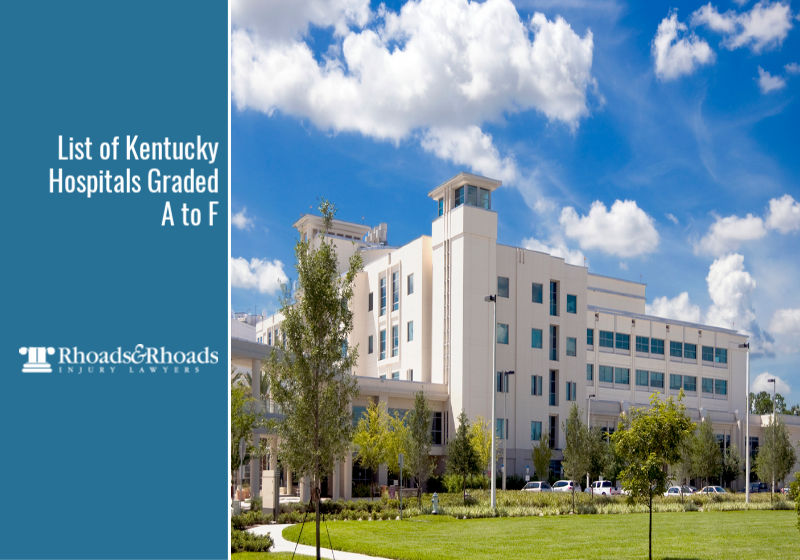
- Across any 48 hours, more than 500 people will die from hospital errors, delays in diagnosis, injuries, adverse events, treatment mistakes, and infections.
- Nearly a third of all patients admitted to a hospital are a victim of some sort of preventable medical error related injury, and there is a 1 in 25 chance of leaving the hospital with a new infection.
- Several Kentucky hospitals were named for having a decline in patient safety and received the lowest and most concerning levels of care ratings by a non-profit watchdog group.
- Any hospital’s wrongful conduct, which causes temporary or permanent physical damage to patients, makes a personal injury suit viable.
List of Kentucky Hospitals That Received Poor Patient Care Grades
Although most hospital errors can be prevented, more than 500 people will die from medical mistakes, injuries, accidents, adverse treatment events, and infections. Luckily, there are watchdog organizations, such as Leapfrog Group, keeping tabs on troubled facilities. Twice a year, Leapfrog sends a voluntary survey to the nation’s hospitals in which about 2,500 participate. Hospitals are asked about 28 specific measures, including hand hygiene, intensive care unit physician staffing, bedsores, falls, C-section rates, episiotomies during childbirth, radiation doses for pediatric patients during CT scans, and more. Each hospital is then graded using data obtained from the Centers for Medicare & Medicaid Services, in addition to the voluntary survey and other supplemental sources.
Based on the feedback provided, including a review of health insurance information, the non-profit then assigns each hospital with a grade of A through F. In the most recent report released in Fall 2019, more Kentucky hospitals earned an A or B grade for patient safety than in the previous survey. But the group also concluded that some of the nation’s most dangerous medical centers included several Kentucky hospitals who were handed a pivotal D or F patient safety grade.
A Graded Hospitals
- Clark Regional Medical Center
- Harrison Memorial Hospital
- Baptist Health Lexington
- Elizabeth Healthcare – Ft. Thomas
- Georgetown Community Hospital
- Elizabeth Healthcare – Edgewood
- Elizabeth Healthcare – Florence
- UofL Health Shelbyville Hospital
- Flaget Memorial Hospital
- Norton Brownsboro Hospital
- Norton Women’s & Children’s Hospital
- Norton Hospital
- Norton Audubon Hospital
B Graded Hospitals
- J. Samson Community Hospital
- Hardin Memorial Hospital
- TriStar Greenview Regional Hospital
- Saint Joseph Hospital
- Owensboro Health
- Baptist Health Paducah
- Saint Joseph East
- Saint Joseph – London
- Whitesburg ARH Hospital
- Mercy Health Lourdes
C Graded Hospitals
- Medical Center at Bowling Green
- Lake Cumberland Regional Hospital
- Baptist Health Madisonville
- Baptist Health Richmond
- Baptist Health Louisville
- Harlan ARH Hospital
- Claire Regional Medical Center
- Saint Joseph Mount Sterling
- Baptist Health Corbin
- Methodist Hospital of Henderson
- Ephraim McDowell Regional Medical Center
- Frankfort Regional Medical Center
- Murray-Calloway County Hospital
- Jackson Taylor Regional Hospital
- Baptist Health La Grange
- Purchase Medical Center
- Tug Valley ARH Medical Center
- Pikeville Medical Center
- King’s Daughters Medical Center
- Our Lady of Bellefonte Hospital
D Graded Hospitals
- Highlands Regional Medical Center
- University of Louisville Hospital
- UK Good Samaritan Hospital
- University of Kentucky Albert B. Chandler Hospital
- Hazard ARH Regional Medical Center
- Mary & Elizabeth Hospital
F Graded Hospitals
- Jewish Hospital, located in Louisville, was the only Kentucky hospital to receive an F grade. The facility and staff at Jewish performed below average for preventing certain infections, including both MRSA and C. diff, and for having a dangerous object left in a patient’s body after surgery. Handwashing, patient falls, and safe medication administration were also noted as failing practices.
Medical professionals should be held responsible for permanent injuries or fatalities made to patients through surgical errors, missed and delayed diagnosis, medication mistakes, childbirth injuries, and other negligent acts.
Preventable Medical Errors Can Turn Deadly
According to the Institute of Medicine, preventable medical errors kill as many as 98,000 people every year at the cost of $29 billion. The most common type of malpractice allegation is an error in diagnosis, followed by errors related to surgery, and errors in association to medication or treatment.
- Misdiagnosis: Missed or delayed diagnoses can cause a patient to endure unnecessary treatments or avoid receiving the right kind of medical help. Misdiagnosis can sometimes lead to an untimely or unexpected death.
- Surgical errors (including anesthesia): These can include mistakes during surgery such as wrong site, wrong procedure, retained surgical instruments left in the body after surgery, anesthesia errors, C-section delivery mistakes leading to maternal and infant injuries, and the use of unclean devices or tools.
- Medication mistakes: Doctors and pharmacists may provide an improper dosage of a given drug or administer two or more medications that harmfully interact. Incorrect dosage is typically the most frequently occurring medication error.
Reduced staffing at medical facilities, failure to train skilled medical workers, unethical and neglectful procedures, and doctors who practice non-standard methods may also result in acts of malpractice.
How You Can Advocate for Hospital Safety
Patients must support their care and do their research when the opportunity to choose a provider is present. Safety grades similar to those provided by Leapfrog can tell you more about things like:
- Does my hospital value patient safety by supporting strong health care teams?
- How well does my hospital prevent infections and encourage handwashing?
- Are there protocols and standards in place for preventing errors at my hospital?
Higher rated hospitals and health systems may not guarantee a smooth experience and zero adverse outcomes either. But knowing a hospital rating when you have a choice between providers may prevent fatal medical errors from happening, diseases from being passed, and your safe recovery to happen sooner.
Owensboro and Madisonville Medical Malpractice Lawyers
If you or a loved one has been a victim of medical malpractice in Kentucky, under the current “statute of limitations” you only have a limited period in which you can bring a claim against a medical provider. It is important to speak with an attorney as soon as you are comfortable and able.
With offices in Owensboro and Madisonville, Rhoads & Rhoads represents medical malpractice victims throughout Western Kentucky. We offer free initial consultations, and all cases are taken on a contingency fee basis. We get paid when we win or settle your case, so there is NO RISK involved. Call us at 888-709-9329 to schedule an appointment with one of our medical malpractice attorneys.
Also read: Overworked Doctors & Nurses Cause Serious Medical Mistakes


